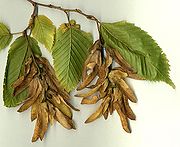Hornbeam
| Hornbeam | |
|---|---|
 |
|
| European Hornbeam foliage | |
| Scientific classification | |
| Kingdom: | Plantae |
| Division: | Magnoliophyta |
| Class: | Magnoliopsida |
| Order: | Fagales |
| Family: | Betulaceae |
| Genus: | Carpinus L. |
| Species | |
|
|
Hornbeams are relatively small hardwood trees in the genus Carpinus (Cár-pi-nus). Though some botanists grouped them with the hazels (Corylus) and hop-hornbeams (Ostrya) in a segregate family, Corylaceae, modern botanists place the hornbeams in the birch subfamily Coryloideae. The 30-40 species occur across much of the north temperate regions, with the greatest number of species in east Asia, particularly China. Only two species occur in Europe, and only one in eastern North America.
The common English name of "hornbeam" derives from the hardness of the wood (likened to horn) and the Old English beam, a tree (cognate with German "baum"). American Hornbeam is also occasionally known as blue-beech, ironwood, or musclewood; the first from the resemblance of the bark to that of the American Beech Fagus grandifolia, the other two from the hardness of the wood and the muscular appearance of the trunk respectively. The botanic name for the genus, Carpinus, is the original Latin name for the European species.

The leaves are deciduous, alternate, and simple with a serrated margin, and typically vary from 3-10 cm in length. The flowers are wind-pollinated pendulous catkins, produced in spring. The male and female flowers are on separate catkins, but on the same tree (monoecious). The fruit is a small nut about 3-6 mm long, held in a leafy bract; the bract may be either trilobed or simple oval, and is slightly asymmetrical. The asymmetry of the seedwing makes it spin as it falls, improving wind dispersal. The shape of the wing is important in the identification of different hornbeam species. There are typically 10-30 seeds on each seed catkin.
Hornbeams are used as food plants by the larvae of some Lepidoptera species including Autumnal Moth, Common Emerald, Feathered Thorn, Svensson's Copper Underwing and Winter Moth (recorded on European Hornbeam) as well as the Coleophora case-bearers C. currucipennella and C. ostryae.

The European Hornbeam (Carpinus betulus), is a small to medium sized tree, typically 10-20 m tall but occasionally reaching 30 m. It is native to most of Europe except for Ireland, northern Britain and most of Scandinavia. The leaves are 5-9 cm long, and the seeds have a 3-4 cm long trilobed bract.
The Oriental Hornbeam (Carpinus orientalis) occurs in southeast Europe and southwest Asia, usually on hot dry sites at lower altitudes than C. betulus, and is a smaller tree, rarely over 10 m tall and often shrubby. It has small leaves, 3-5 cm long. The seeds differ from C. betulus in having a simple bract (not trilobed), about 2 cm long.
The Japanese Hornbeam (Carpinus japonica) is similar to C. orientalis in having unlobed seed bracts, but differs from it in having larger leaves, 8-10 cm long.
The North American species, American Hornbeam (Carpinus caroliniana) is similar to C. betulus in leaf size and shape. The seed bract is also trilobed, but less deeply than in C. betulus. The trunk and limbs have a distinct 'muscled' shape, with long smooth rounded ridges running lengthwise. The bark is smooth bluish-grey, similar but even finer in texture to the American Beech Fagus grandifolia. It is commonly referred to as iron-wood, blue-beech or muscle-wood. Note that the appellation 'iron-wood' is also used for Ostrya virginiana (Eastern Hophornbeam, American Hophornbeam) and these two trees' ranges overlap in parts of Eastern North America.
Hornbeams yield a very hard timber, giving rise to the name iron-wood. Dried heartwood billets are nearly white and are suitable for decorative use. For general carpentry, hornbeam is rarely used, partly due to the difficulty of working it. Its hardness has however lent it to use for carving boards, tool handles, handplane soles, coach wheels, piano actions and other situations where a very tough, hard wood is required, perhaps most interestingly as gear pegs in simple machines, including traditional windmills. It is sometimes coppiced to provide hardwood poles. It is also used in parquet flooring.
